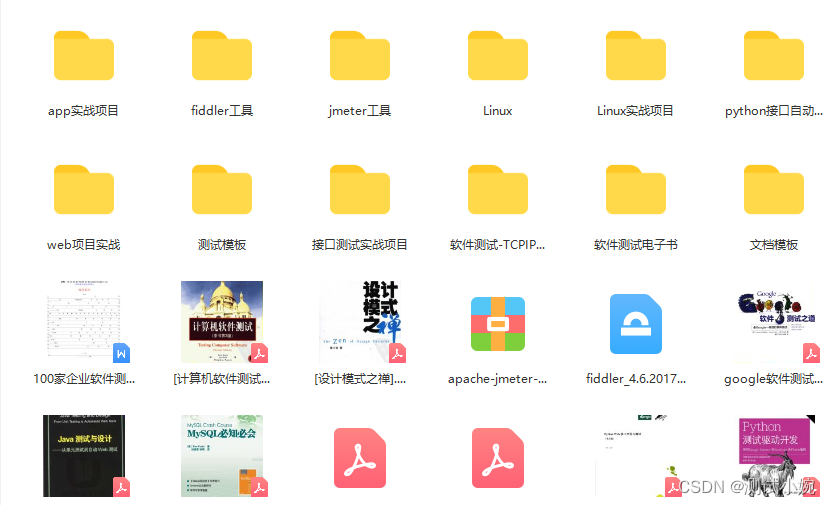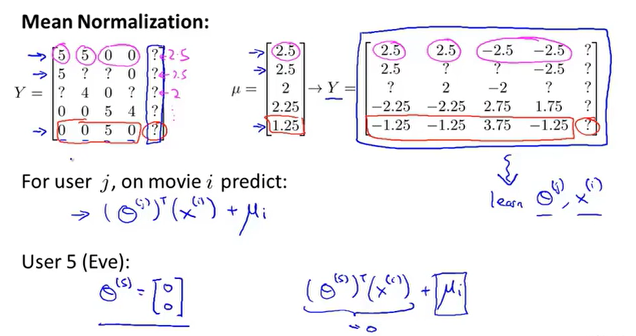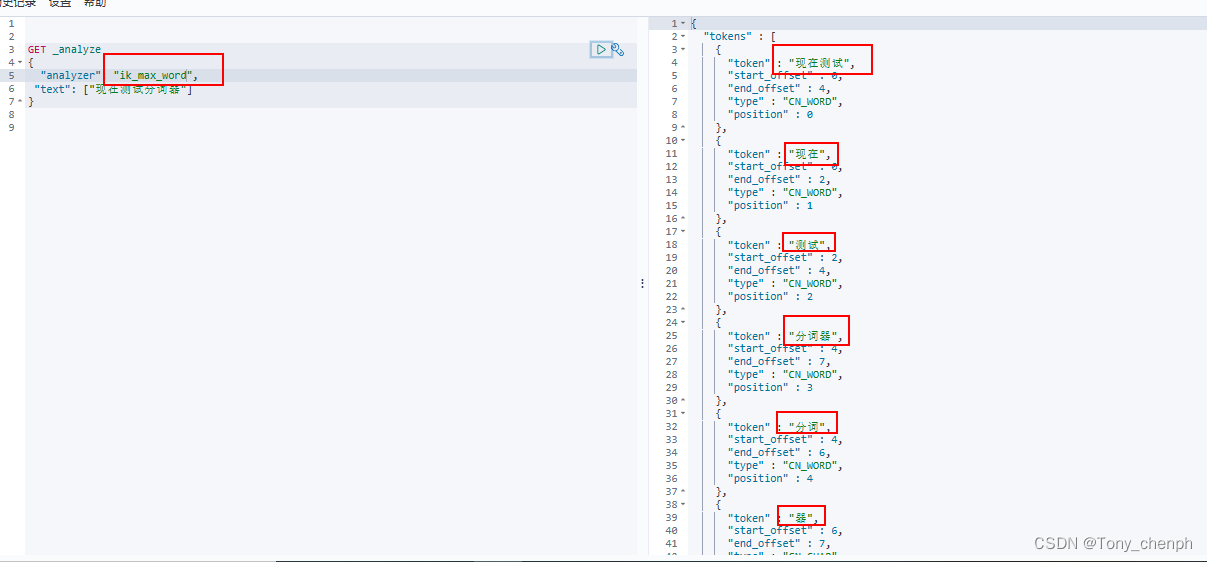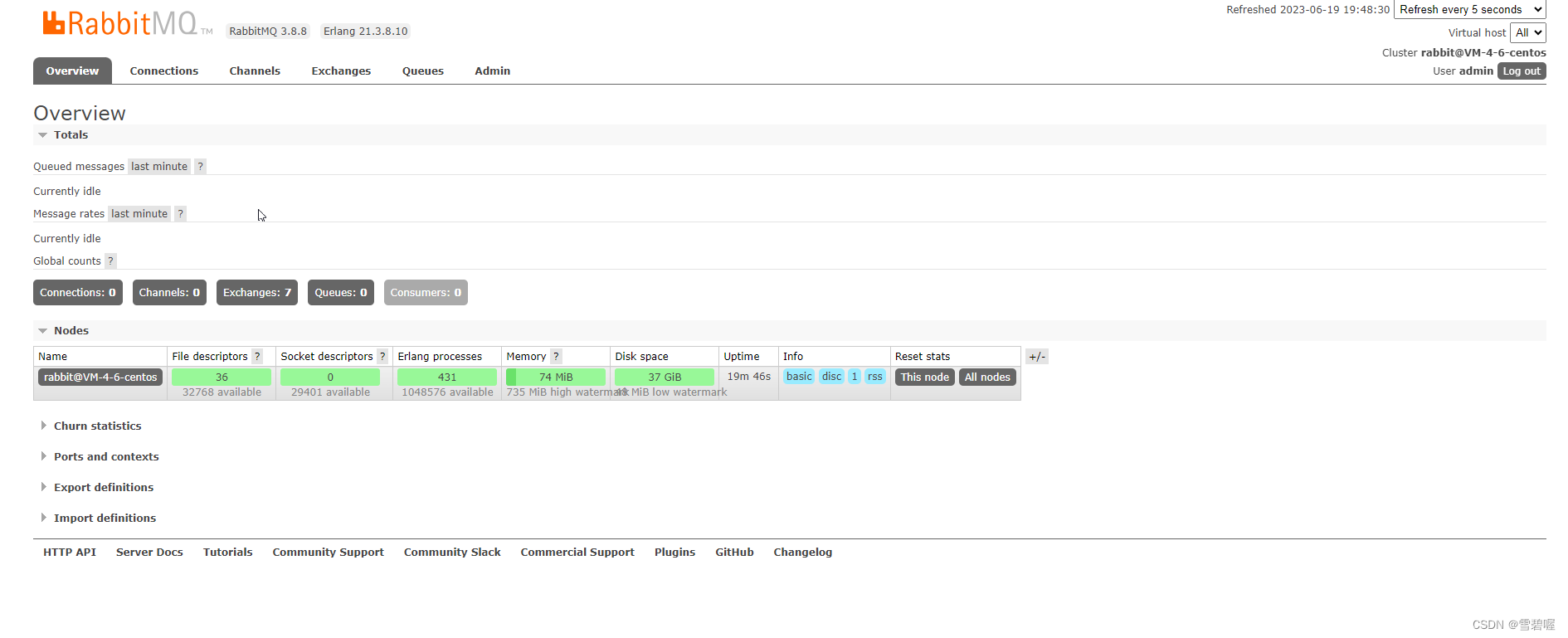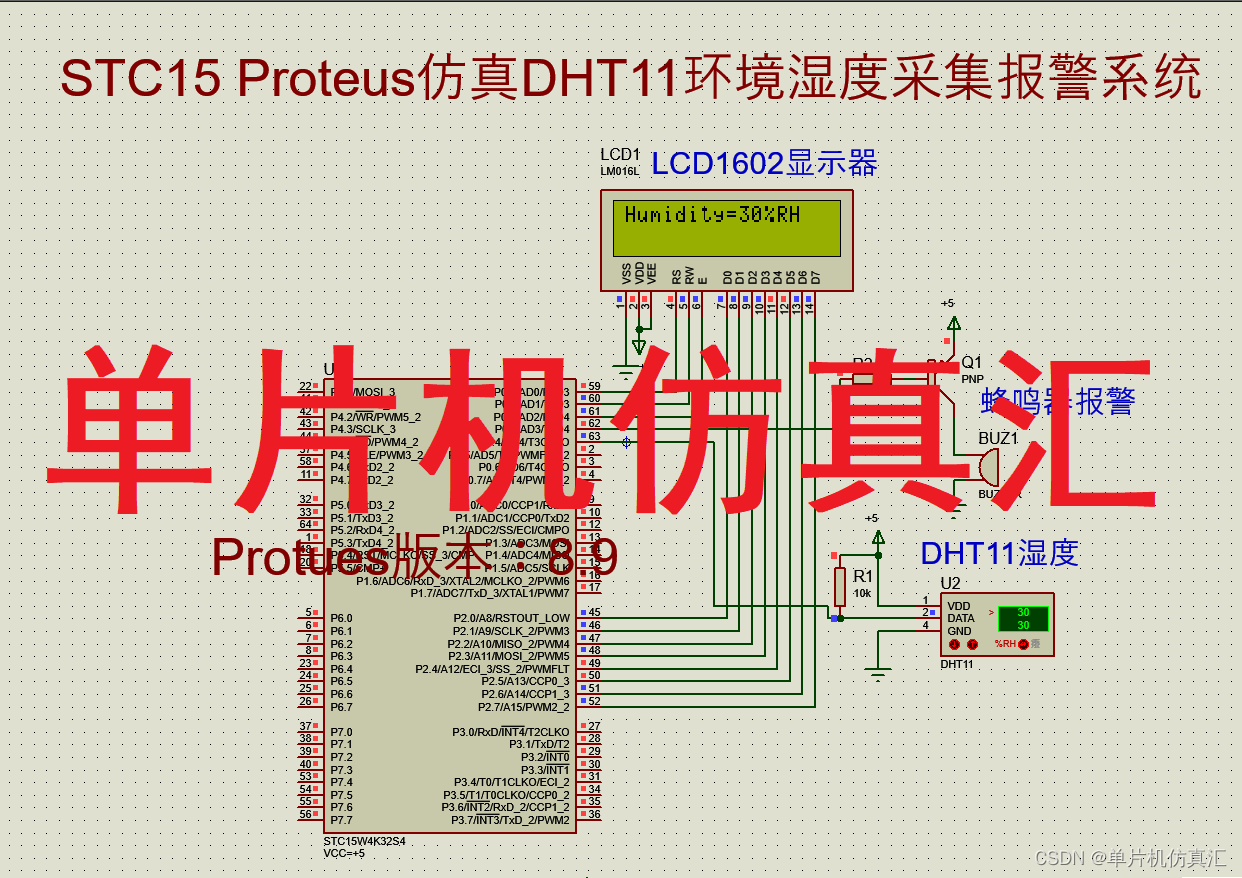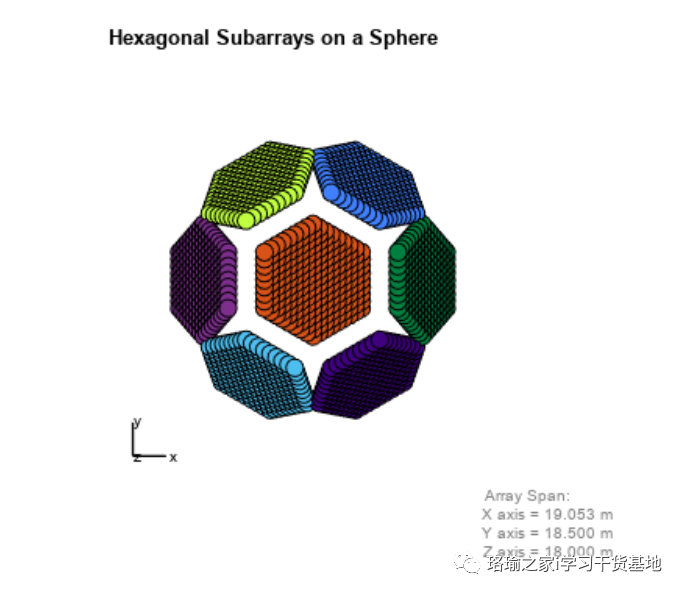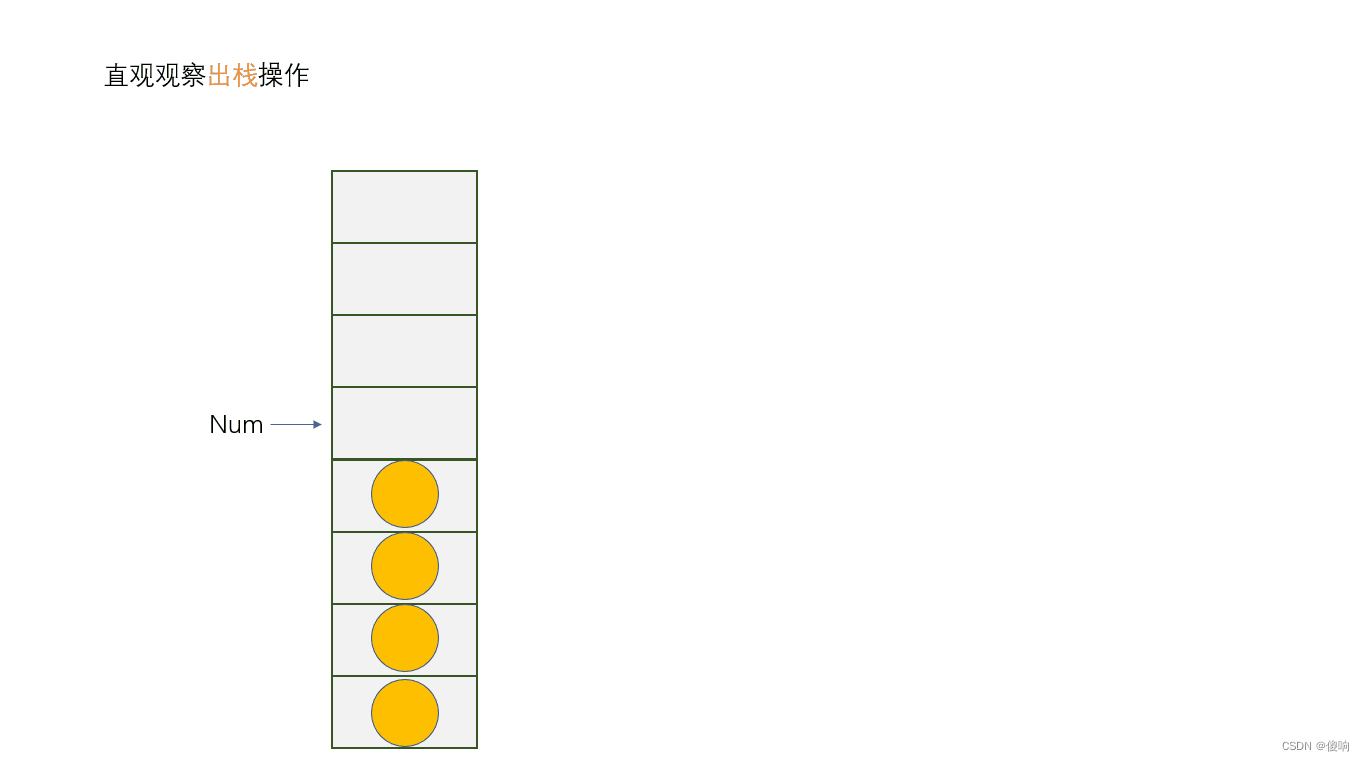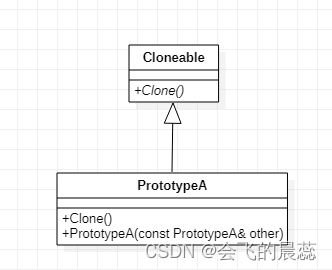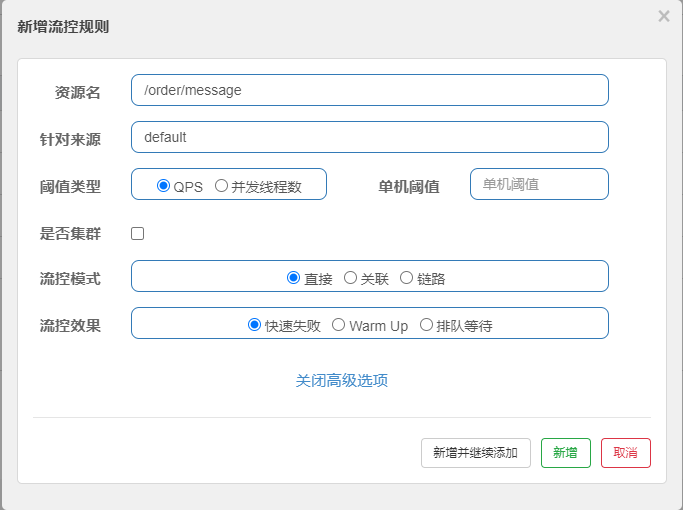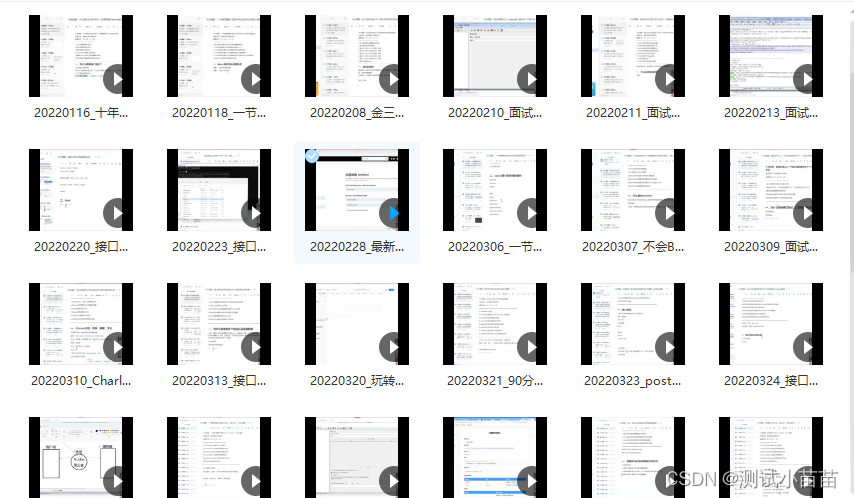六、OAuth2.0
6.1、OAuth2.0介绍
OAuth(开放授权)是一个开放标准,允许用户授权第三方应用访问他们存储在另外的服务提供者上的信息,而不需要将用户名和密码提供给第三方应用或分享他们数据的所有内容。OAuth2.0是OAuth协议的延续版本,但不向后兼容OAuth 1.0即完全废止了OAuth1.0。很多大公司如Google,Yahoo,Microsoft等都提供了OAUTH认证服务,这些都足以说明OAUTH标准逐渐成为开放资源授权的标准。
Oauth协议目前发展到2.0版本,1.0版本过于复杂,2.0版本已得到广泛应用。
参考:https://baike.baidu.com/item/oAuth/7153134?fr=aladdin
Oauth协议:https://tools.ietf.org/html/rfc6749
下边分析一个Oauth2认证的例子,通过例子去理解OAuth2.0协议的认证流程,本例子是昂焱数据网站使用微信认证的过程,这个过程的简要描述如下:
用户借助微信认证登录昂焱数据网站,用户就不用单独在昂焱数据注册用户,怎么样算认证成功吗?昂焱数据网站需要成功从微信获取用户的身份信息则认为用户认证成功,那如何从微信获取用户的身份信息?用户信息的拥有者是用户本人,微信需要经过用户的同意方可为昂焱数据网站生成令牌,昂焱数据网站拿此令牌方可从微信获取用户的信息。
1、客户端请求第三方授权
- 用户进入昂焱数据程序的登录页面,点击微信的图标以微信账号登录系统,用户是自己在微信里信息的资源拥有者。点击“微信”出现一个二维码,此时用户扫描二维码,开始给昂焱数据授权。
2、资源拥有者同意给客户端授权
- 资源拥有者扫描二维码表示资源拥有者同意给客户端授权,微信会对资源拥有者的身份进行验证, 验证通过后,微信会询问用户是否给授权昂焱数据访问自己的微信数据,用户点击“确认登录”表示同意授权,微信认证服务器会颁发一个授权码,并重定向到昂焱数据的网站。
3、客户端获取到授权码,请求认证服务器申请令牌
- 此过程用户看不到,客户端应用程序请求认证服务器,请求携带授权码。
4、认证服务器向客户端响应令牌
- 微信认证服务器验证了客户端请求的授权码,如果合法则给客户端颁发令牌,令牌是客户端访问资源的通行证。
此交互过程用户看不到,当客户端拿到令牌后,用户在昂焱数据看到已经登录成功。
5、客户端请求资源服务器的资源
- 客户端携带令牌访问资源服务器的资源。昂焱数据网站携带令牌请求访问微信服务器获取用户的基本信息。
6、资源服务器返回受保护资源
- 资源服务器校验令牌的合法性,如果合法则向用户响应资源信息内容。
以上认证授权详细的执行流程如下:
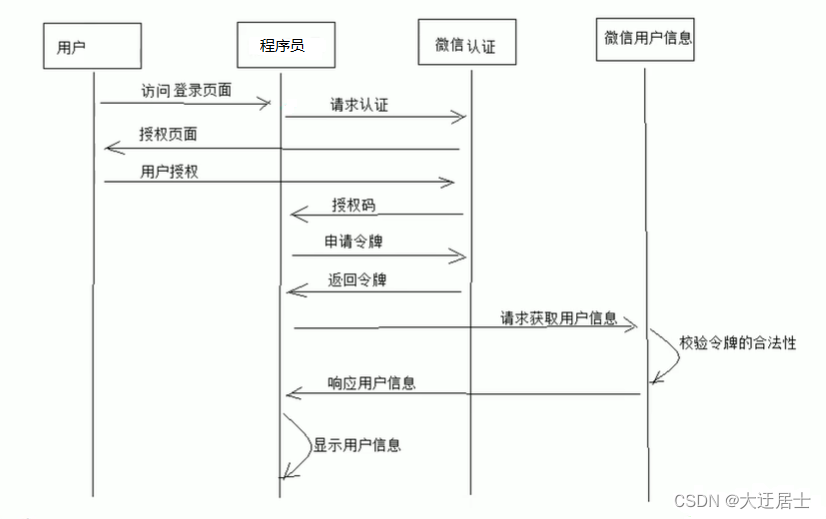
通过上边的例子我们大概了解了OAauth2.0的认证过程,下边我们看OAuth2.0认证流程:
引自OAauth2.0协议 https://tools.ietf.org/html/rfc6749
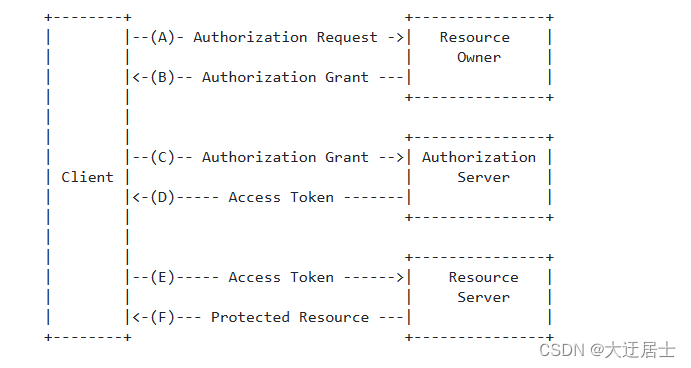
OAauth2.0包括以下角色:
1、客户端
- 本身不存储资源,需要通过资源拥有者的授权去请求资源服务器的资源,比如:Android客户端、Web客户端(浏览器端)、微信客户端等。
2、资源拥有者
- 通常为用户,也可以是应用程序,即该资源的拥有者。
3、授权服务器(也称认证服务器)
- 用于服务提供商对资源拥有的身份进行认证、对访问资源进行授权,认证成功后会给客户端发放令牌(access_token),作为客户端访问资源服务器的凭据。本例为微信的认证服务器。
4、资源服务器
- 存储资源的服务器,本例子为微信存储的用户信息。
现在还有一个问题,服务提供商能允许随便一个客户端就接入到它的授权服务器吗?
答案是否定的,服务提供商会给准入的接入方一个身份,用于接入时的凭据:client_id:客户端标识 client_secret:客户端秘钥
因此,准确来说,授权服务器对两种OAuth2.0中的两个角色进行认证授权,分别是资源拥有者、客户端。
6.2、Spring Cloud Security OAuth2
6.2.1、环境介绍
Spring-Security-OAuth2是对OAuth2的一种实现,并且跟我们之前学习的Spring Security相辅相成,与Spring Cloud体系的集成也非常便利,接下来,我们需要对它进行学习,最终使用它来实现我们设计的分布式认证授权解决方案。
OAuth2.0的服务提供方涵盖两个服务,即授权服务 (Authorization Server,也叫认证服务) 和资源服务 (Resource Server),使用 Spring Security OAuth2 的时候你可以选择把它们在同一个应用程序中实现,也可以选择建立使用同一个授权服务的多个资源服务。
授权服务 (Authorization Server)应包含对接入端以及登入用户的合法性进行验证并颁发token等功能,对令牌的请求端点由 Spring MVC 控制器进行实现,下面是配置一个认证服务必须要实现的endpoints:
- AuthorizationEndpoint 服务于认证请求。默认 URL: /oauth/authorize 。
- TokenEndpoint 服务于访问令牌的请求。默认 URL: /oauth/token 。
资源服务 (Resource Server),应包含对资源的保护功能,对非法请求进行拦截,对请求中token进行解析鉴权等,下面的过滤器用于实现 OAuth 2.0 资源服务:
- OAuth2AuthenticationProcessingFilter用来对请求给出的身份令牌解析鉴权。
接下来分别创建uaa授权服务(也可叫认证服务)和order订单资源服务。
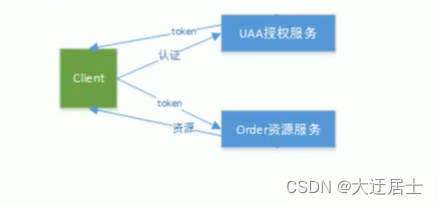
认证流程如下:
- 1、客户端请求UAA授权服务进行认证。
- 2、认证通过后由UAA颁发令牌。
- 3、客户端携带令牌Token请求资源服务。
- 4、资源服务校验令牌的合法性,合法即返回资源信息。
6.2.2、环境搭建
6.2.2.1、父工程
创建maven工程作为父工程,依赖如下:
<?xml version="1.0" encoding="UTF-8"?>
<project xmlns="http://maven.apache.org/POM/4.0.0"
xmlns:xsi="http://www.w3.org/2001/XMLSchema-instance"
xsi:schemaLocation="http://maven.apache.org/POM/4.0.0 http://maven.apache.org/xsd/maven-4.0.0.xsd">
<modelVersion>4.0.0</modelVersion>
<groupId>com.test.security</groupId>
<artifactId>distributed-security</artifactId>
<version>1.0-SNAPSHOT</version>
<packaging>pom</packaging>
<parent>
<groupId>org.springframework.boot</groupId>
<artifactId>spring-boot-starter-parent</artifactId>
<version>2.1.3.RELEASE</version>
</parent>
<properties>
<project.build.sourceEncoding>UTF-8</project.build.sourceEncoding>
<project.reporting.outputEncoding>UTF-8</project.reporting.outputEncoding>
<java.version>1.8</java.version>
</properties>
<dependencyManagement>
<dependencies>
<dependency>
<groupId>org.springframework.cloud</groupId>
<artifactId>spring-cloud-dependencies</artifactId>
<version>Greenwich.RELEASE</version>
<type>pom</type>
<scope>import</scope>
</dependency>
<dependency>
<groupId>javax.servlet</groupId>
<artifactId>javax.servlet-api</artifactId>
<version>3.1.0</version>
<scope>provided</scope>
</dependency>
<dependency>
<groupId>javax.interceptor</groupId>
<artifactId>javax.interceptor-api</artifactId>
<version>1.2</version>
</dependency>
<dependency>
<groupId>com.alibaba</groupId>
<artifactId>fastjson</artifactId>
<version>1.2.47</version>
</dependency>
<dependency>
<groupId>org.projectlombok</groupId>
<artifactId>lombok</artifactId>
<version>1.18.0</version>
</dependency>
<dependency>
<groupId>mysql</groupId>
<artifactId>mysql-connector-java</artifactId>
<version>5.1.47</version>
</dependency>
<dependency>
<groupId>org.springframework.security</groupId>
<artifactId>spring-security-jwt</artifactId>
<version>1.0.10.RELEASE</version>
</dependency>
<dependency>
<groupId>org.springframework.security.oauth.boot</groupId>
<artifactId>spring-security-oauth2-autoconfigure</artifactId>
<version>2.1.3.RELEASE</version>
</dependency>
</dependencies>
</dependencyManagement>
<build>
<finalName>${project.name}</finalName>
<resources>
<resource>
<directory>src/main/resources</directory>
<filtering>true</filtering>
<includes>
<include>**/*</include>
</includes>
</resource>
<resource>
<directory>src/main/java</directory>
<includes>
<include>**/*.xml</include>
</includes>
</resource>
</resources>
<plugins>
<!--<plugin>
<groupId>org.springframework.boot</groupId>
<artifactId>spring-boot-maven-plugin</artifactId>
</plugin>-->
<plugin>
<groupId>org.apache.maven.plugins</groupId>
<artifactId>maven-compiler-plugin</artifactId>
<configuration>
<source>1.8</source>
<target>1.8</target>
</configuration>
</plugin>
<plugin>
<artifactId>maven-resources-plugin</artifactId>
<configuration>
<encoding>utf-8</encoding>
<useDefaultDelimiters>true</useDefaultDelimiters>
</configuration>
</plugin>
</plugins>
</build>
</project>
6.2.2.2、创建UAA授权服务工程
6.2.2.2.1、创建distributed-security-uaa
创建distributed-security-uaa作为授权服务工程,依赖如下:
<?xml version="1.0" encoding="UTF-8"?>
<project xmlns="http://maven.apache.org/POM/4.0.0"
xmlns:xsi="http://www.w3.org/2001/XMLSchema-instance"
xsi:schemaLocation="http://maven.apache.org/POM/4.0.0 http://maven.apache.org/xsd/maven-4.0.0.xsd">
<parent>
<artifactId>distributed-security</artifactId>
<groupId>com.test.security</groupId>
<version>1.0-SNAPSHOT</version>
</parent>
<modelVersion>4.0.0</modelVersion>
<artifactId>distributed-security-uaa</artifactId>
<dependencies>
<dependency>
<groupId>org.springframework.cloud</groupId>
<artifactId>spring-cloud-starter-netflix-eureka-client</artifactId>
</dependency>
<dependency>
<groupId>org.springframework.cloud</groupId>
<artifactId>spring-cloud-starter-netflix-hystrix</artifactId>
</dependency>
<dependency>
<groupId>org.springframework.cloud</groupId>
<artifactId>spring-cloud-starter-netflix-ribbon</artifactId>
</dependency>
<dependency>
<groupId>org.springframework.cloud</groupId>
<artifactId>spring-cloud-starter-openfeign</artifactId>
</dependency>
<dependency>
<groupId>com.netflix.hystrix</groupId>
<artifactId>hystrix-javanica</artifactId>
</dependency>
<dependency>
<groupId>org.springframework.retry</groupId>
<artifactId>spring-retry</artifactId>
</dependency>
<dependency>
<groupId>org.springframework.boot</groupId>
<artifactId>spring-boot-starter-actuator</artifactId>
</dependency>
<dependency>
<groupId>org.springframework.boot</groupId>
<artifactId>spring-boot-starter-web</artifactId>
</dependency>
<dependency>
<groupId>org.springframework.boot</groupId>
<artifactId>spring-boot-starter-freemarker</artifactId>
</dependency>
<dependency>
<groupId>org.springframework.data</groupId>
<artifactId>spring-data-commons</artifactId>
</dependency>
<dependency>
<groupId>org.springframework.cloud</groupId>
<artifactId>spring-cloud-starter-security</artifactId>
</dependency>
<dependency>
<groupId>org.springframework.cloud</groupId>
<artifactId>spring-cloud-starter-oauth2</artifactId>
</dependency>
<dependency>
<groupId>org.springframework.security</groupId>
<artifactId>spring-security-jwt</artifactId>
</dependency>
<dependency>
<groupId>javax.interceptor</groupId>
<artifactId>javax.interceptor-api</artifactId>
</dependency>
<dependency>
<groupId>mysql</groupId>
<artifactId>mysql-connector-java</artifactId>
</dependency>
<dependency>
<groupId>org.springframework.boot</groupId>
<artifactId>spring-boot-starter-jdbc</artifactId>
</dependency>
<dependency>
<groupId>com.alibaba</groupId>
<artifactId>fastjson</artifactId>
</dependency>
<dependency>
<groupId>org.projectlombok</groupId>
<artifactId>lombok</artifactId>
</dependency>
</dependencies>
</project>
6.2.2.2.2、启动类
本工程采用SpringBoot开发,每个工程编写一个启动类:
@SpringBootApplication
@EnableDiscoveryClient
@EnableHystrix
@EnableFeignClients(basePackages = {"com.test.security.distributed.uaa"})
public class UAAServer {
public static void main(String[] args) {
SpringApplication.run(UAAServer.class, args);
}
}
6.2.2.2.3、配置文件
在resources下创建application.properties
spring.application.name=uaa-service
server.port=53020
spring.main.allow-bean-definition-overriding = true
logging.level.root = debug
logging.level.org.springframework.web = info
spring.http.encoding.enabled = true
spring.http.encoding.charset = UTF-8
spring.http.encoding.force = true
server.tomcat.remote_ip_header = x-forwarded-for
server.tomcat.protocol_header = x-forwarded-proto
server.use-forward-headers = true
server.servlet.context-path = /uaa
spring.freemarker.enabled = true
spring.freemarker.suffix = .html
spring.freemarker.request-context-attribute = rc
spring.freemarker.content-type = text/html
spring.freemarker.charset = UTF-8
spring.mvc.throw-exception-if-no-handler-found = true
spring.resources.add-mappings = false
spring.datasource.url = jdbc:mysql://localhost:3306/user_db?useUnicode=true
spring.datasource.username = root
spring.datasource.password = mysql
spring.datasource.driver-class-name = com.mysql.jdbc.Driver
eureka.client.serviceUrl.defaultZone = http://localhost:53000/eureka/
eureka.instance.preferIpAddress = true
eureka.instance.instance-id = ${spring.application.name}:${spring.cloud.client.ip-address}:${spring.application.instance_id:${server.port}}
management.endpoints.web.exposure.include = refresh,health,info,env
feign.hystrix.enabled = true
feign.compression.request.enabled = true
feign.compression.request.mime-types[0] = text/xml
feign.compression.request.mime-types[1] = application/xml
feign.compression.request.mime-types[2] = application/json
feign.compression.request.min-request-size = 2048
feign.compression.response.enabled = true
6.2.2.3、创建Order资源服务工程
本工程为Order订单服务工程,访问本工程的资源需要认证通过。
本工程的目的主要是测试认证授权的功能,所以不涉及订单管理相关业务。
6.2.2.3.1、创建distributed-security-order工程
<?xml version="1.0" encoding="UTF-8"?>
<project xmlns="http://maven.apache.org/POM/4.0.0"
xmlns:xsi="http://www.w3.org/2001/XMLSchema-instance"
xsi:schemaLocation="http://maven.apache.org/POM/4.0.0 http://maven.apache.org/xsd/maven-4.0.0.xsd">
<parent>
<artifactId>distributed-security</artifactId>
<groupId>com.test.security</groupId>
<version>1.0-SNAPSHOT</version>
</parent>
<modelVersion>4.0.0</modelVersion>
<artifactId>distributed-security-order</artifactId>
<dependencies>
<dependency>
<groupId>org.springframework.cloud</groupId>
<artifactId>spring-cloud-starter-netflix-eureka-client</artifactId>
</dependency>
<dependency>
<groupId>org.springframework.boot</groupId>
<artifactId>spring-boot-starter-actuator</artifactId>
</dependency>
<dependency>
<groupId>org.springframework.boot</groupId>
<artifactId>spring-boot-starter-web</artifactId>
</dependency>
<dependency>
<groupId>org.springframework.cloud</groupId>
<artifactId>spring-cloud-starter-security</artifactId>
</dependency>
<dependency>
<groupId>org.springframework.cloud</groupId>
<artifactId>spring-cloud-starter-oauth2</artifactId>
</dependency>
<dependency>
<groupId>javax.interceptor</groupId>
<artifactId>javax.interceptor-api</artifactId>
</dependency>
<dependency>
<groupId>com.alibaba</groupId>
<artifactId>fastjson</artifactId>
</dependency>
<dependency>
<groupId>org.projectlombok</groupId>
<artifactId>lombok</artifactId>
</dependency>
</dependencies>
</project>
6.2.2.3.2、启动类
@SpringBootApplication
@EnableDiscoveryClient
public class OrderServer {
public static void main(String[] args) {
SpringApplication.run(OrderServer.class, args);
}
}
6.2.2.3.3、配置文件
在resources中创建application.properties
spring.application.name=order-service
server.port=53021
spring.main.allow-bean-definition-overriding = true
logging.level.root = debug
logging.level.org.springframework.web = info
spring.http.encoding.enabled = true
spring.http.encoding.charset = UTF-8
spring.http.encoding.force = true
server.tomcat.remote_ip_header = x-forwarded-for
server.tomcat.protocol_header = x-forwarded-proto
server.use-forward-headers = true
server.servlet.context-path = /order
spring.freemarker.enabled = true
spring.freemarker.suffix = .html
spring.freemarker.request-context-attribute = rc
spring.freemarker.content-type = text/html
spring.freemarker.charset = UTF-8
spring.mvc.throw-exception-if-no-handler-found = true
spring.resources.add-mappings = false
eureka.client.serviceUrl.defaultZone = http://localhost:53000/eureka/
eureka.instance.preferIpAddress = true
eureka.instance.instance-id = ${spring.application.name}:${spring.cloud.client.ip-address}:${spring.application.instance_id:${server.port}}
management.endpoints.web.exposure.include = refresh,health,info,env
feign.hystrix.enabled = true
feign.compression.request.enabled = true
feign.compression.request.mime-types[0] = text/xml
feign.compression.request.mime-types[1] = application/xml
feign.compression.request.mime-types[2] = application/json
feign.compression.request.min-request-size = 2048
feign.compression.response.enabled = true
6.2.3、授权服务器配置
6.2.3.1、EnableAuthorizationServer
可以用 @EnableAuthorizationServer 注解并继承AuthorizationServerConfigurerAdapter来配置OAuth2.0 授权服务器。
在Config包下创建AuthorizationServer:
@Configuration
@EnableAuthorizationServer
public class AuthorizationServer extends AuthorizationServerConfigurerAdapter {
//略...
}
AuthorizationServerConfigurerAdapter要求配置以下几个类,这几个类是由Spring创建的独立的配置对象,它们会被Spring传入AuthorizationServerConfigurer中进行配置。
public class AuthorizationServerConfigurerAdapter implements AuthorizationServerConfigurer {
public AuthorizationServerConfigurerAdapter() {}
public void configure(AuthorizationServerSecurityConfigurer security) throws Exception {}
public void configure(ClientDetailsServiceConfigurer clients) throws Exception {}
public void configure(AuthorizationServerEndpointsConfigurer endpoints) throws Exception {}
}
-
ClientDetailsServiceConfigurer:用来配置客户端详情服务(ClientDetailsService),客户端详情信息在这里进行初始化,你能够把客户端详情信息写死在这里或者是通过数据库来存储调取详情信息。
-
AuthorizationServerEndpointsConfigurer:用来配置令牌(token)的访问端点和令牌服务(token services)。
-
AuthorizationServerSecurityConfigurer:用来配置令牌端点的安全约束.
6.2.3.2、配置客户端详细信息
ClientDetailsServiceConfigurer 能够使用内存或者JDBC来实现客户端详情服务(ClientDetailsService),ClientDetailsService负责查找ClientDetails,而ClientDetails有几个重要的属性如下列表:
-
clientId:(必须的)用来标识客户的Id。
-
secret:(需要值得信任的客户端)客户端安全码,如果有的话。
-
scope:用来限制客户端的访问范围,如果为空(默认)的话,那么客户端拥有全部的访问范围。
-
authorizedGrantTypes:此客户端可以使用的授权类型,默认为空。
-
authorities:此客户端可以使用的权限(基于Spring Security authorities)。
-
redirectUris: 回调地址。授权服务会往该回调地址推送此客户端相关的信息。
客户端详情(Client Details)能够在应用程序运行的时候进行更新,可以通过访问底层的存储服务(例如将客户端详情存储在一个关系数据库的表中,就可以使用 JdbcClientDetailsService)或者通过自己实现ClientRegistrationService接口(同时你也可以实现 ClientDetailsService 接口)来进行管理。
我们暂时使用内存方式存储客户端详情信息,配置如下:
@Configuration
@EnableAuthorizationServer
public class AuthorizationServer extends AuthorizationServerConfigurerAdapter {
//配置客户端详细信息服务
@Override
public void configure(ClientDetailsServiceConfigurer clients) throws Exception {
// clients.withClientDetails(clientDetailsService);
clients.inMemory()// 使用in‐memory存储
.withClient("c1")// client_id
.secret(new BCryptPasswordEncoder().encode("secret"))//客户端密钥
.resourceIds("res1")//资源列表
.authorizedGrantTypes("authorization_code","password","client_credentials","implicit","refresh_token")// 该client允许的授权类型authorization_code,password,refresh_token,implicit,client_credentials
.scopes("all")// 允许的授权范围
.autoApprove(false)//false代表跳转到授权页面
//加上验证回调地址
.redirectUris("http://www.baidu.com");
}
}
6.2.3.3、管理令牌
AuthorizationServerTokenServices 接口定义了一些操作使得你可以对令牌进行一些必要的管理,令牌可以被用来加载身份信息,里面包含了这个令牌的相关权限。自己可以创建 AuthorizationServerTokenServices 这个接口的实现,则需要继承 DefaultTokenServices 这个类,里面包含了一些有用实现,你可以使用它来修改令牌的格式和令牌的存储。默认的,当它尝试创建一个令牌的时候,是使用随机值来进行填充的,除了持久化令牌是委托一个 TokenStore 接口来实现以外,这个类几乎帮你做了所有的事情。并且 TokenStore 这个接口有一个默认的实现,它就是InMemoryTokenStore ,如其命名,所有的令牌是被保存在了内存中。除了使用这个类以外,你还可以使用一些其他的预定义实现,下面有几个版本,它们都实现了TokenStore接口:
-
InMemoryTokenStore:这个版本的实现是被默认采用的,它可以完美的工作在单服务器上(即访问并发量压力不大的情况下,并且它在失败的时候不会进行备份),大多数的项目都可以使用这个版本的实现来进行尝试,你可以在开发的时候使用它来进行管理,因为不会被保存到磁盘中,所以更易于调试。
-
JdbcTokenStore:这是一个基于JDBC的实现版本,令牌会被保存进关系型数据库。使用这个版本的实现时,你可以在不同的服务器之间共享令牌信息,使用这个版本的时候请注意把"spring-jdbc"这个依赖加入到你的classpath当中。
-
JwtTokenStore:这个版本的全称是 JSON Web Token(JWT),它可以把令牌相关的数据进行编码(因此对于后端服务来说,它不需要进行存储,这将是一个重大优势),但是它有一个缺点,那就是撤销一个已经授权令牌将会非常困难,所以它通常用来处理一个生命周期较短的令牌以及撤销刷新令牌(refresh_token)。另外一个缺点就是这个令牌占用的空间会比较大,如果你加入了比较多用户凭证信息。JwtTokenStore 不会保存任何数据,但是它在转换令牌值以及授权信息方面与DefaultTokenServices 所扮演的角色是一样的。
1、定义TokenConfig
在config包下定义TokenConfig,我们暂时先使用InMemoryTokenStore,生成一个普通的令牌。
@Configuration
public class TokenConfig {
@Bean
public TokenStore tokenStore() {
//内存方式生成普通令牌
return new InMemoryTokenStore();
}
}
2、定义AuthorizationServerTokenServices
在AuthorizationServer中定义AuthorizationServerTokenServices
@Configuration
@EnableAuthorizationServer
public class AuthorizationServer extends AuthorizationServerConfigurerAdapter {
@Autowired
private TokenStore tokenStore;
@Autowired
private ClientDetailsService clientDetailsService;
//令牌管理服务
@Bean
public AuthorizationServerTokenServices tokenService() {
DefaultTokenServices service=new DefaultTokenServices();
//客户端信息服务
service.setClientDetailsService(clientDetailsService);
//是否刷新令牌
service.setSupportRefreshToken(true);
//令牌存储策略
service.setTokenStore(tokenStore);
// 令牌默认有效期2小时
service.setAccessTokenValiditySeconds(7200);
// 刷新令牌默认有效期3天
service.setRefreshTokenValiditySeconds(259200);
return service;
}
}
6.2.3.4、令牌访问端点配置
AuthorizationServerEndpointsConfigurer 这个对象的实例可以完成令牌服务以及令牌endpoint配置。
配置授权类型(Grant Types)
AuthorizationServerEndpointsConfigurer 通过设定以下属性决定支持的授权类型(Grant Types):
-
authenticationManager:认证管理器,当你选择了资源所有者密码(password)授权类型的时候,请设置这个属性注入一个 AuthenticationManager 对象。
-
userDetailsService:如果你设置了这个属性的话,那说明你有一个自己的 UserDetailsService 接口的实现,或者你可以把这个东西设置到全局域上面去(例如 GlobalAuthenticationManagerConfigurer 这个配置对象),当你设置了这个之后,那么 “refresh_token” 即刷新令牌授权类型模式的流程中就会包含一个检查,用来确保这个账号是否仍然有效,假如说你禁用了这个账户的话。
-
authorizationCodeServices:这个属性是用来设置授权码服务的(即 AuthorizationCodeServices 的实例对象),主要用于 “authorization_code” 授权码类型模式。
-
implicitGrantService:这个属性用于设置隐式授权模式,用来管理隐式授权模式的状态。
-
tokenGranter:当你设置了这个东西(即 TokenGranter 接口实现),那么授权将会交由你来完全掌控,并且会忽略掉上面的这几个属性,这个属性一般是用作拓展用途的,即标准的四种授权模式已经满足不了你的需求的时候,才会考虑使用这个。
配置授权端点的URL(Endpoint URLs):
AuthorizationServerEndpointsConfigurer 这个配置对象有一个叫做 pathMapping() 的方法用来配置端点URL链接,它有两个参数:
- 第一个参数:String 类型的,这个端点URL的默认链接。
- 第二个参数:String 类型的,你要进行替代的URL链接。
以上的参数都将以 “/” 字符为开始的字符串,框架的默认URL链接如下列表,可以作为这个 pathMapping() 方法的第一个参数:
- /oauth/authorize:授权端点。
- /oauth/token:令牌端点。
- /oauth/confirm_access:用户确认授权提交端点。
- /oauth/error:授权服务错误信息端点。
- /oauth/check_token:用于资源服务访问的令牌解析端点。
- /oauth/token_key:提供公有密匙的端点,如果你使用JWT令牌的话。
需要注意的是授权端点这个URL应该被Spring Security保护起来只供授权用户访问.在AuthorizationServer配置令牌访问端点
@Configuration
@EnableAuthorizationServer
public class AuthorizationServer extends AuthorizationServerConfigurerAdapter {
@Autowired
private AuthorizationCodeServices authorizationCodeServices;
@Autowired
private AuthenticationManager authenticationManager;
//令牌访问端点
@Override
public void configure(AuthorizationServerEndpointsConfigurer endpoints) {
endpoints
.authenticationManager(authenticationManager)//密码模式需要
.authorizationCodeServices(authorizationCodeServices)//授权码模式需要
.tokenServices(tokenService())//令牌管理服务
.allowedTokenEndpointRequestMethods(HttpMethod.POST);//允许post提交
}
@Bean
public AuthorizationCodeServices authorizationCodeServices() {
//设置授权码模式的授权码如何存取,暂时采用内存方式
return new InMemoryAuthorizationCodeServices();
}
}
6.2.3.5、令牌端点的安全约束
AuthorizationServerSecurityConfigurer:用来配置令牌端点(Token Endpoint)的安全约束,在AuthorizationServer中配置如下.
@Configuration
@EnableAuthorizationServer
public class AuthorizationServer extends AuthorizationServerConfigurerAdapter {
//令牌访问端点安全策略
@Override
public void configure(AuthorizationServerSecurityConfigurer security){
security
.tokenKeyAccess("permitAll()") // oauth/token_key这个endpoint当使用JwtToken且使用非对称加密时,资源服务用于获取公钥而开放的,这里指这个endpoint完全公开。
.checkTokenAccess("permitAll()") // oauth/check_token这个endpoint完全公开
.allowFormAuthenticationForClients();//允许表单认证
}
}
授权服务配置总结:授权服务配置分成三大块,可以关联记忆。
-
既然要完成认证,它首先得知道客户端信息从哪儿读取,因此要进行客户端详情配置。
-
既然要颁发token,那必须得定义token的相关endpoint,以及token如何存取,以及客户端支持哪些类型的token。
-
既然暴露除了一些endpoint,那对这些endpoint可以定义一些安全上的约束等。
6.2.3.6、web安全配置
@Configuration
@EnableGlobalMethodSecurity(securedEnabled = true,prePostEnabled = true)
public class WebSecurityConfig extends WebSecurityConfigurerAdapter {
@Bean
public PasswordEncoder passwordEncoder() {
return new BCryptPasswordEncoder();
}
//认证管理器
@Bean
public AuthenticationManager authenticationManagerBean() throws Exception {
return super.authenticationManagerBean();
}
//安全拦截机制(最重要)
@Override
protected void configure(HttpSecurity http) throws Exception {
http.csrf().disable()
.authorizeRequests()
.antMatchers("/r/r1").hasAnyAuthority("p1")
.antMatchers("/login*").permitAll()
.anyRequest().authenticated()
.and()
.formLogin();
}
}
6.2.4、授权码模式
6.2.4.1、授权码模式介绍
下图是授权码模式交互图:
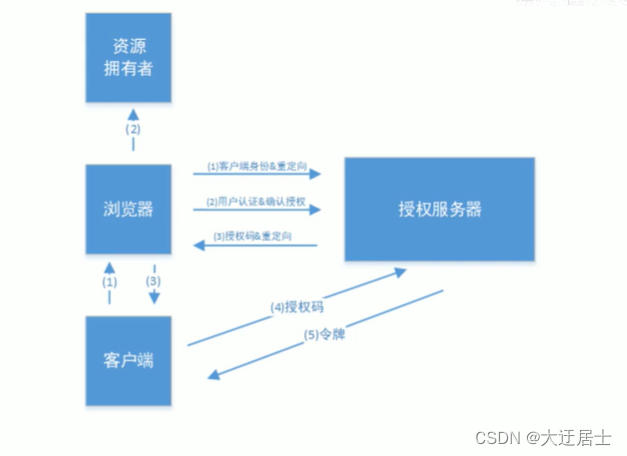
(1)资源拥有者打开客户端,客户端要求资源拥有者给予授权,它将浏览器被重定向到授权服务器,重定向时会附加客户端的身份信息。如:
/uaa/oauth/authorize?client_id=c1&response_type=code&scope=all&redirect_uri=http://www.baidu.com
参数列表如下:
- client_id:客户端准入标识。
- response_type:授权码模式固定为code。
- scope:客户端权限。
- redirect_uri:跳转uri,当授权码申请成功后会跳转到此地址,并在后边带上code参数(授权码)。
(2)浏览器出现向授权服务器授权页面,之后将用户同意授权。
(3)授权服务器将授权码(AuthorizationCode)转经浏览器发送给client(通过redirect_uri)。
(4)客户端拿着授权码向授权服务器索要访问access_token,请求如下:
/uaa/oauth/token?client_id=c1&client_secret=secret&grant_type=authorization_code&code=5PgfcD&redirect_uri=http://www.baidu.com
参数列表如下
- client_id:客户端准入标识。
- client_secret:客户端秘钥。
- grant_type:授权类型,填写authorization_code,表示授权码模式
- code:授权码,就是刚刚获取的授权码,注意:授权码只使用一次就无效了,需要重新申请。
- redirect_uri:申请授权码时的跳转url,一定和申请授权码时用的redirect_uri一致。
(5)授权服务器返回令牌(access_token)
这种模式是四种模式中最安全的一种模式。一般用于client是Web服务器端应用或第三方的原生App调用资源服务的时候。因为在这种模式中access_token不会经过浏览器或移动端的App,而是直接从服务端去交换,这样就最大限度的减小了令牌泄漏的风险。
6.2.4.2、测试
浏览器访问认证页面:
http://localhost:53020/uaa/oauth/authorize?client_id=c1&response_type=code&scope=all&redirect_uri=http://www.baidu.com
然后输入模拟的账号和密码点登陆之后进入授权页面:
确认授权后,浏览器会重定向到指定路径(oauth_client_details表中的web_server_redirect_uri)并附加验证码?code=DB2mFj(每次不一样),最后使用该验证码获取token。
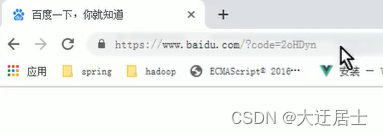
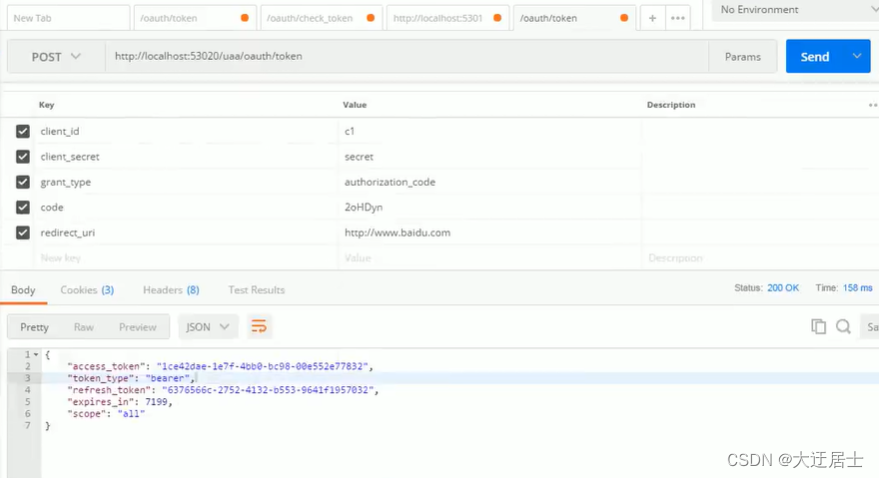
6.2.5、简化模式
6.2.5.1、简化模式介绍
下图是简化模式交互图:
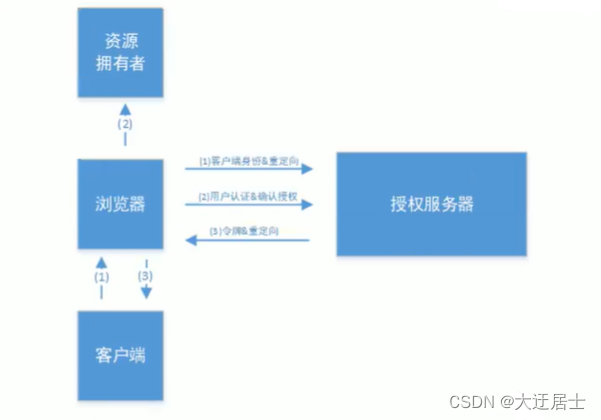
(1)资源拥有者打开客户端,客户端要求资源拥有者给予授权,它将浏览器被重定向到授权服务器,重定向时会附加客户端的身份信息。如:
/uaa/oauth/authorize?client_id=c1&response_type=token&scope=all&redirect_uri=http://www.baidu.com
参数描述同授权码模式 ,注意response_type=token,说明是简化模式。
(2)浏览器出现向授权服务器授权页面,之后将用户同意授权。
(3)授权服务器将授权码将令牌(access_token)以Hash的形式存放在重定向uri的fargment中发送给浏览器。
注:fragment 主要是用来标识 URI 所标识资源里的某个资源,在 URI 的末尾通过 (#)作为 fragment 的开头,其中 # 不属于 fragment 的值。如https://domain/index#L18这个 URI 中 L18 就是 fragment 的值。大家只需要知道js通过响应浏览器地址栏变化的方式能获取到fragment 就行了。
一般来说,简化模式用于没有服务器端的第三方单页面应用,因为没有服务器端就无法接收授权码。
6.2.5.2、测试
浏览器访问认证页面:
http://localhost:53020/uaa/oauth/authorize?client_id=c1&response_type=token&scope=all&redirect_uri=http://www.baidu.com
然后输入模拟的账号和密码点登陆之后进入授权页面:
确认授权后,浏览器会重定向到指定路径(oauth_client_details表中的web_server_redirect_uri)并以Hash的形式存放在重定向uri的fargment中,如:
http://aa.bb.cc/receive#access_token=eyJhbGciOiJIUzI1NiIsInR5cCI6IkpXVCJ9.eyJ0ZW5hbn...
6.2.6、密码模式
6.2.6.1、授权码模式介绍
下图是密码模式交互图:
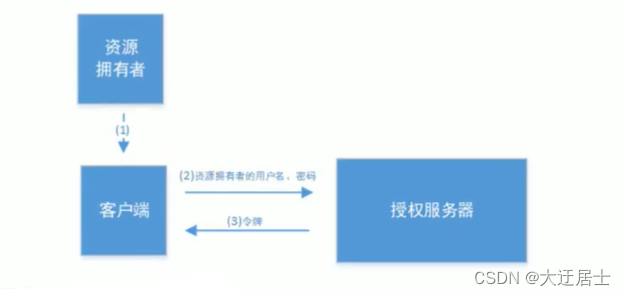
(1)资源拥有者将用户名、密码发送给客户端
(2)客户端拿着资源拥有者的用户名、密码向授权服务器请求令牌(access_token),请求如下:
/uaa/oauth/token?client_id=c1&client_secret=secret&grant_type=password&username=shangsan&password=123
参数列表如下:
- client_id:客户端准入标识。
- client_secret:客户端秘钥。
- grant_type:授权类型,填写password表示密码模式
- username:资源拥有者用户名。
- password:资源拥有者密码。
(3)授权服务器将令牌(access_token)发送给client
这种模式十分简单,但是却意味着直接将用户敏感信息泄漏给了client,因此这就说明这种模式只能用于client是我们自己开发的情况下。因此密码模式一般用于我们自己开发的,第一方原生App或第一方单页面应用。
6.2.6.2、测试
POST http://localhost:53020/uaa/oauth/token
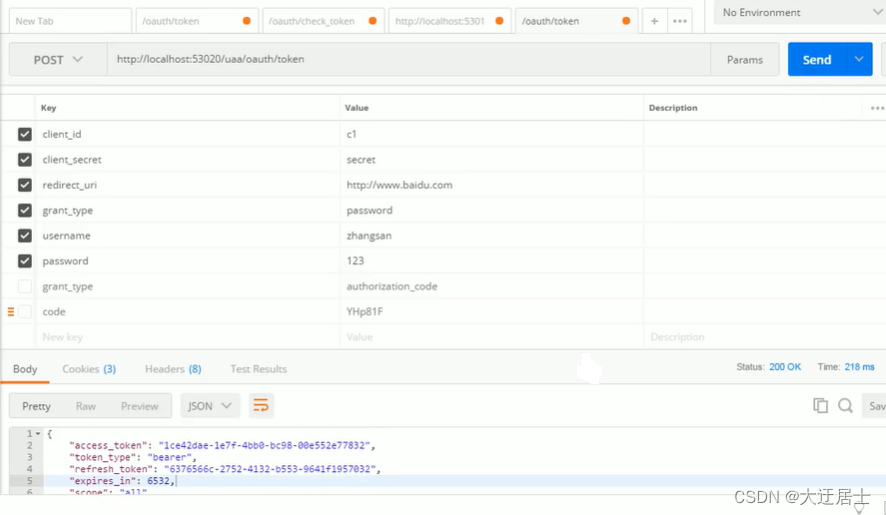
6.2.7、客户端模式
6.2.7.1、客户端模式介绍

(1)客户端向授权服务器发送自己的身份信息,并请求令牌(access_token)
(2)确认客户端身份无误后,将令牌(access_token)发送给client,请求如下:
/uaa/oauth/token?client_id=c1&client_secret=secret&grant_type=client_credentials
参数列表如下:
- client_id:客户端准入标识。
- client_secret:客户端秘钥。
- grant_type:授权类型,填写client_credentials表示客户端模式
这种模式是最方便但最不安全的模式。因此这就要求我们对client完全的信任,而client本身也是安全的。因此这种模式一般用来提供给我们完全信任的服务器端服务。比如,合作方系统对接,拉取一组用户信息。
6.2.7.2、测试
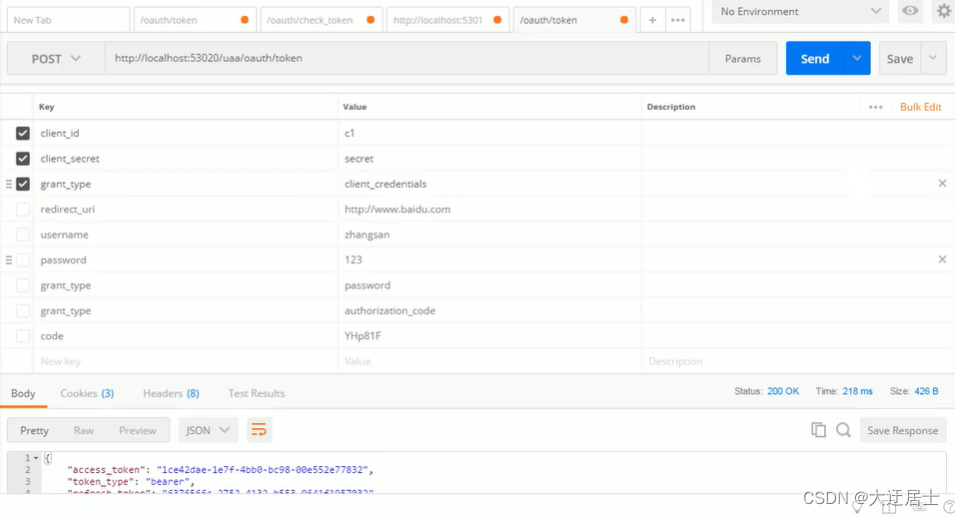
6.2.8、资源服务测试
6.2.8.1、资源服务器配置
@EnableResourceServer 注解到一个 @Configuration 配置类上,并且必须使用 ResourceServerConfigurer 这个配置对象来进行配置(可以选择继承自 ResourceServerConfigurerAdapter 然后覆写其中的方法,参数就是这个对象的实例),下面是一些可以配置的属性:
ResourceServerSecurityConfigurer中主要包括:
- tokenServices:ResourceServerTokenServices 类的实例,用来实现令牌服务。
- tokenStore:TokenStore类的实例,指定令牌如何访问,与tokenServices配置可选
- resourceId:这个资源服务的ID,这个属性是可选的,但是推荐设置并在授权服务中进行验证。
- 其他的拓展属性例如 tokenExtractor 令牌提取器用来提取请求中的令牌。
HttpSecurity配置这个与Spring Security类似:
- 请求匹配器,用来设置需要进行保护的资源路径,默认的情况下是保护资源服务的全部路径。
- 通过http.authorizeRequests()来设置受保护资源的访问规则
- 其他的自定义权限保护规则通过 HttpSecurity 来进行配置。
@EnableResourceServer 注解自动增加了一个类型为 OAuth2AuthenticationProcessingFilter 的过滤器链
编写ResouceServerConfig:
@Configuration
@EnableResourceServer
@EnableGlobalMethodSecurity(prePostEnabled = true)
public class ResouceServerConfig extends ResourceServerConfigurerAdapter {
public static final String RESOURCE_ID = "res1";
@Override
public void configure(ResourceServerSecurityConfigurer resources) {
resources.resourceId(RESOURCE_ID)
.tokenServices(tokenService())
.stateless(true);
}
@Override
public void configure(HttpSecurity http) throws Exception {
http
.authorizeRequests()
.antMatchers("/**").access("#oauth2.hasScope('all')")
.and().csrf().disable()
.sessionManagement().sessionCreationPolicy(SessionCreationPolicy.STATELESS);
}
}
6.2.8.2、验证token
ResourceServerTokenServices 是组成授权服务的另一半,如果你的授权服务和资源服务在同一个应用程序上的话,你可以使用 DefaultTokenServices ,这样的话,你就不用考虑关于实现所有必要的接口的一致性问题。如果你的资源服务器是分离开的,那么你就必须要确保能够有匹配授权服务提供的 ResourceServerTokenServices,它知道如何对令牌进行解码。
令牌解析方法: 使用 DefaultTokenServices 在资源服务器本地配置令牌存储、解码、解析方式 使用RemoteTokenServices 资源服务器通过 HTTP 请求来解码令牌,每次都请求授权服务器端点 /oauth/check_token
使用授权服务的 /oauth/check_token 端点你需要在授权服务将这个端点暴露出去,以便资源服务可以进行访问,这在咱们授权服务配置中已经提到了,下面是一个例子,在这个例子中,我们在授权服务中配置了/oauth/check_token 和 /oauth/token_key 这两个端点:
@Override
public void configure(AuthorizationServerSecurityConfigurer security) throws Exception {
security
.tokenKeyAccess("permitAll()")// /oauth/token_key 安全配置
.checkTokenAccess("permitAll()") // /oauth/check_token 安全配置
}
在资源 服务配置RemoteTokenServices ,在ResouceServerConfig中配置:
@Configuration
@EnableResourceServer
@EnableGlobalMethodSecurity(prePostEnabled = true)
public class ResouceServerConfig extends ResourceServerConfigurerAdapter {
//资源服务令牌解析服务
@Bean
public ResourceServerTokenServices tokenService() {
//使用远程服务请求授权服务器校验token,必须指定校验token 的url、client_id,client_secret
RemoteTokenServices service=new RemoteTokenServices();
service.setCheckTokenEndpointUrl("http://localhost:53020/uaa/oauth/check_token");
service.setClientId("c1");
service.setClientSecret("secret");
return service;
}
@Override
public void configure(ResourceServerSecurityConfigurer resources) {
resources.resourceId(RESOURCE_ID)
.tokenServices(tokenService())
.stateless(true);
}
}
6.2.8.3、编写资源
在controller包下编写OrderController,此controller表示订单资源的访问类:
@RestController
public class OrderController {
@GetMapping(value = "/r1")
@PreAuthorize("hasAnyAuthority('p1')")
public String r1(){
return "访问资源1";
}
}
6.2.8.4、添加安全访问控制
@Configuration
@EnableGlobalMethodSecurity(securedEnabled = true,prePostEnabled = true)
public class WebSecurityConfig extends WebSecurityConfigurerAdapter {
//安全拦截机制(最重要)
@Override
protected void configure(HttpSecurity http) throws Exception {
http.csrf().disable()
.authorizeRequests()
// .antMatchers("/r/r1").hasAuthority("p2")
// .antMatchers("/r/r2").hasAuthority("p2")
.antMatchers("/r/**").authenticated()//所有/r/**的请求必须认证通过
.anyRequest().permitAll();//除了/r/**,其它的请求可以访问
}
}
6.2.8.5、测试
1、申请令牌
这里我们使用密码方式
2、请求资源
按照oauth2.0协议要求,请求资源需要携带token,如下:
token的参数名称为:Authorization,值为:Bearer token值
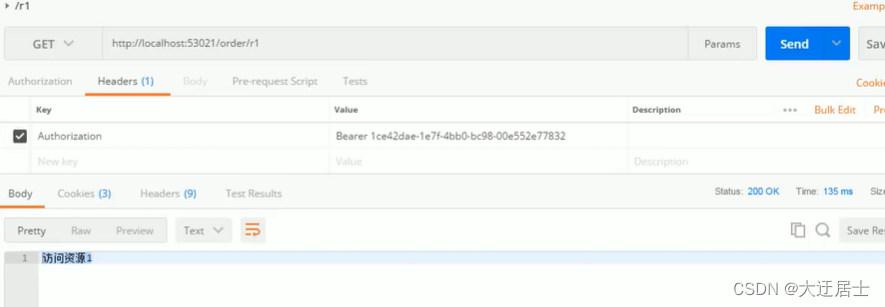
6.3、JWT令牌
6.3.1、JWT介绍
通过上边的测试我们发现,当资源服务和授权服务不在一起时资源服务使用RemoteTokenServices 远程请求授权服务验证token,如果访问量较大将会影响系统的性能 。
解决上边问题:
令牌采用JWT格式即可解决上边的问题,用户认证通过会得到一个JWT令牌,JWT令牌中已经包括了用户相关的信息,客户端只需要携带JWT访问资源服务,资源服务根据事先约定的算法自行完成令牌校验,无需每次都请求认证服务完成授权。
6.3.1.1、什么是JWT?
JSON Web Token(JWT)是一个开放的行业标准(RFC 7519),它定义了一种简介的、自包含的协议格式,用于在通信双方传递json对象,传递的信息经过数字签名可以被验证和信任。JWT可以使用HMAC算法或使用RSA的公钥/私钥对来签名,防止被篡改。
官网:https://jwt.io/
标准:https://tools.ietf.org/html/rfc7519
JWT令牌的优点:
- 1)jwt基于json,非常方便解析。
- 2)可以在令牌中自定义丰富的内容,易扩展。
- 3)通过非对称加密算法及数字签名技术,JWT防止篡改,安全性高。
- 4)资源服务使用JWT可不依赖认证服务即可完成授权。
缺点:
- 1)JWT令牌较长,占存储空间比较大。
6.3.1.2、JWT令牌结构
通过学习JWT令牌结构为自定义jwt令牌打好基础。
JWT令牌由三部分组成,每部分中间使用点(.)分隔,比如:xxxxx.yyyyy.zzzzz
6.3.1.2.1、Header
头部包括令牌的类型(即JWT)及使用的哈希算法(如HMAC SHA256或RSA)
比如:
下边是Header部分的内容
{
"alg": "HS256",
"typ": "JWT"
}
将上边的内容使用Base64Url编码,得到一个字符串就是JWT令牌的第一部分。
6.3.1.2.2、Payload
第二部分是负载,内容也是一个json对象,它是存放有效信息的地方,它可以存放jwt提供的现成字段,比如:iss(签发者),exp(过期时间戳), sub(面向的用户)等,也可自定义字段。
此部分不建议存放敏感信息,因为此部分可以解码还原原始内容。
最后将第二部分负载使用Base64Url编码,得到一个字符串就是JWT令牌的第二部分。
比如:
{
"sub": "1234567890",
"name": "456",
"admin": true
}
6.3.1.2.3、Signature
第三部分是签名,此部分用于防止jwt内容被篡改。
这个部分使用base64url将前两部分进行编码,编码后使用点(.)连接组成字符串,最后使用header中声明签名算法进行签名。
比如:
HMACSHA256(base64UrlEncode(header) + "." + base64UrlEncode(payload),secret)
base64UrlEncode(header):jwt令牌的第一部分。
base64UrlEncode(payload):jwt令牌的第二部分。
secret:签名所使用的密钥。
6.3.2、配置JWT令牌服务
在uaa中配置jwt令牌服务,即可实现生成jwt格式的令牌。
1、TokenConfig
@Configuration
public class TokenConfig {
private String SIGNING_KEY = "uaa123";
@Bean
public TokenStore tokenStore() {
return new JwtTokenStore(accessTokenConverter());
}
@Bean
public JwtAccessTokenConverter accessTokenConverter() {
JwtAccessTokenConverter converter = new JwtAccessTokenConverter();
converter.setSigningKey(SIGNING_KEY); //对称秘钥,资源服务器使用该秘钥来验证
return converter;
}
}
2、定义JWT令牌服务
@Configuration
@EnableAuthorizationServer
public class AuthorizationServer extends AuthorizationServerConfigurerAdapter {
@Autowired
private JwtAccessTokenConverter accessTokenConverter;
//令牌管理服务
@Bean
public AuthorizationServerTokenServices tokenService() {
DefaultTokenServices service=new DefaultTokenServices();
service.setClientDetailsService(clientDetailsService);//客户端详情服务
service.setSupportRefreshToken(true);//支持刷新令牌
service.setTokenStore(tokenStore);//令牌存储策略
//令牌增强
TokenEnhancerChain tokenEnhancerChain = new TokenEnhancerChain();
tokenEnhancerChain.setTokenEnhancers(Arrays.asList(accessTokenConverter));
service.setTokenEnhancer(tokenEnhancerChain);
service.setAccessTokenValiditySeconds(7200); // 令牌默认有效期2小时
service.setRefreshTokenValiditySeconds(259200); // 刷新令牌默认有效期3天
return service;
}
6.3.3、生成jwt令牌

6.3.4、校验jwt令牌
资源服务需要和授权服务拥有一致的签字、令牌服务等:
1、将授权服务中的TokenConfig类拷贝到资源 服务中
2、屏蔽资源 服务原来的令牌服务类
@Configuration
@EnableResourceServer
public class ResouceServerConfig extends ResourceServerConfigurerAdapter {
public static final String RESOURCE_ID = "res1";
@Autowired
TokenStore tokenStore;
@Override
public void configure(ResourceServerSecurityConfigurer resources) {
resources.resourceId(RESOURCE_ID)//资源 id
.tokenStore(tokenStore)
.stateless(true);
}
}
6.4、完善环境配置
截止目前客户端信息和授权码仍然存储在内存中,生产环境中通过会存储在数据库中,下边完善环境的配置:
6.4.1、创建表
在user_db中创建如下表:
DROP TABLE IF EXISTS `oauth_client_details`;
CREATE TABLE `oauth_client_details` (
`client_id` varchar(255) CHARACTER SET utf8 COLLATE utf8_general_ci NOT NULL COMMENT '客户端标识',
`resource_ids` varchar(255) CHARACTER SET utf8 COLLATE utf8_general_ci NULL DEFAULT NULL COMMENT '接入资源列表',
`client_secret` varchar(255) CHARACTER SET utf8 COLLATE utf8_general_ci NULL DEFAULT NULL COMMENT '客户端秘钥',
`scope` varchar(255) CHARACTER SET utf8 COLLATE utf8_general_ci NULL DEFAULT NULL,
`authorized_grant_types` varchar(255) CHARACTER SET utf8 COLLATE utf8_general_ci NULL DEFAULT NULL,
`web_server_redirect_uri` varchar(255) CHARACTER SET utf8 COLLATE utf8_general_ci NULL DEFAULT NULL,
`authorities` varchar(255) CHARACTER SET utf8 COLLATE utf8_general_ci NULL DEFAULT NULL,
`access_token_validity` int(11) NULL DEFAULT NULL,
`refresh_token_validity` int(11) NULL DEFAULT NULL,
`additional_information` longtext CHARACTER SET utf8 COLLATE utf8_general_ci NULL,
`create_time` timestamp(0) NOT NULL DEFAULT CURRENT_TIMESTAMP(0) ON UPDATE CURRENT_TIMESTAMP(0),
`archived` tinyint(4) NULL DEFAULT NULL,
`trusted` tinyint(4) NULL DEFAULT NULL,
`autoapprove` varchar(255) CHARACTER SET utf8 COLLATE utf8_general_ci NULL DEFAULT NULL,
PRIMARY KEY (`client_id`) USING BTREE
) ENGINE = InnoDB CHARACTER SET = utf8 COLLATE = utf8_general_ci COMMENT = '接入客户端信息' ROW_FORMAT = Dynamic;
INSERT INTO `oauth_client_details` VALUES ('c1', 'res1','$2a$10$NlBC84MVb7F95EXYTXwLneXgCca6/GipyWR5NHm8K0203bSQMLpvm', 'ROLE_ADMIN,ROLE_USER,ROLE_API','client_credentials,password,authorization_code,implicit,refresh_token', 'http://www.baidu.com',NULL, 7200, 259200, NULL, '2019‐09‐09 16:04:28', 0, 0, 'false');
INSERT INTO `oauth_client_details` VALUES ('c2', 'res2','$2a$10$NlBC84MVb7F95EXYTXwLneXgCca6/GipyWR5NHm8K0203bSQMLpvm', 'ROLE_API','client_credentials,password,authorization_code,implicit,refresh_token', 'http://www.baidu.com',NULL, 31536000, 2592000, NULL, '2019‐09‐09 21:48:51', 0, 0, 'false');
oauth_code表,Spring Security OAuth2使用,用来存储授权码:
DROP TABLE IF EXISTS `oauth_code`;
CREATE TABLE `oauth_code` (
`create_time` timestamp(0) NOT NULL DEFAULT CURRENT_TIMESTAMP,
`code` varchar(255) CHARACTER SET utf8 COLLATE utf8_general_ci NULL DEFAULT NULL,
`authentication` blob NULL,
INDEX `code_index`(`code`) USING BTREE
) ENGINE = InnoDB CHARACTER SET = utf8 COLLATE = utf8_general_ci ROW_FORMAT = Compact;
6.4.2、配置授权服务
(1)修改AuthorizationServer:
ClientDetailsService和AuthorizationCodeServices从数据库读取数据。
//将客户端信息存储到数据库
@Bean
public ClientDetailsService clientDetailsService(DataSource dataSource) {
ClientDetailsService clientDetailsService = new JdbcClientDetailsService(dataSource);
((JdbcClientDetailsService) clientDetailsService).setPasswordEncoder(passwordEncoder);
return clientDetailsService;
}
//配置令牌(token)的访问端点
@Bean
public AuthorizationCodeServices authorizationCodeServices(DataSource dataSource) {
return new JdbcAuthorizationCodeServices(dataSource);//设置授权码模式的授权码如何存取
}
七、Spring Security实现分布式系统授权
7.1、需求分析

-
1、UAA认证服务负责认证授权。
-
2、所有请求经过 网关到达微服务
-
3、网关负责鉴权客户端以及请求转发
-
4、网关将token解析后传给微服务,微服务进行授权。
7.1.1、UAA认证服务代码
AuthorizationServer
@Configuration
@EnableAuthorizationServer
public class AuthorizationServer extends AuthorizationServerConfigurerAdapter {
@Autowired
private TokenStore tokenStore;
@Autowired
private ClientDetailsService clientDetailsService;
@Autowired
private AuthorizationCodeServices authorizationCodeServices;
@Autowired
private AuthenticationManager authenticationManager;
@Autowired
private JwtAccessTokenConverter accessTokenConverter;
@Autowired
PasswordEncoder passwordEncoder;
//将客户端信息存储到数据库
@Bean
public ClientDetailsService clientDetailsService(DataSource dataSource) {
ClientDetailsService clientDetailsService = new JdbcClientDetailsService(dataSource);
((JdbcClientDetailsService) clientDetailsService).setPasswordEncoder(passwordEncoder);
return clientDetailsService;
}
//客户端详情服务
@Override
public void configure(ClientDetailsServiceConfigurer clients) throws Exception {
clients.withClientDetails(clientDetailsService);
}
//令牌管理服务
@Bean
public AuthorizationServerTokenServices tokenService() {
DefaultTokenServices service=new DefaultTokenServices();
service.setClientDetailsService(clientDetailsService);//客户端详情服务
service.setSupportRefreshToken(true);//支持刷新令牌
service.setTokenStore(tokenStore);//令牌存储策略
//令牌增强
TokenEnhancerChain tokenEnhancerChain = new TokenEnhancerChain();
tokenEnhancerChain.setTokenEnhancers(Arrays.asList(accessTokenConverter));
service.setTokenEnhancer(tokenEnhancerChain);
service.setAccessTokenValiditySeconds(7200); // 令牌默认有效期2小时
service.setRefreshTokenValiditySeconds(259200); // 刷新令牌默认有效期3天
return service;
}
//设置授权码模式的授权码如何存取,从数据库取
@Bean
public AuthorizationCodeServices authorizationCodeServices(DataSource dataSource) {
return new JdbcAuthorizationCodeServices(dataSource);//设置授权码模式的授权码如何存取
}
//令牌访问端点
@Override
public void configure(AuthorizationServerEndpointsConfigurer endpoints) {
endpoints
.authenticationManager(authenticationManager)//认证管理器
.authorizationCodeServices(authorizationCodeServices)//授权码服务
.tokenServices(tokenService())//令牌管理服务
.allowedTokenEndpointRequestMethods(HttpMethod.POST);
}
//令牌访问端点安全策略
@Override
public void configure(AuthorizationServerSecurityConfigurer security){
security
.tokenKeyAccess("permitAll()") //oauth/token_key是公开
.checkTokenAccess("permitAll()") //oauth/check_token公开
.allowFormAuthenticationForClients() //表单认证(申请令牌)
;
}
}
TokenConfig
@Configuration
public class TokenConfig {
private String SIGNING_KEY = "uaa123";
@Bean
public TokenStore tokenStore() {
//JWT令牌存储方案
return new JwtTokenStore(accessTokenConverter());
}
@Bean
public JwtAccessTokenConverter accessTokenConverter() {
JwtAccessTokenConverter converter = new JwtAccessTokenConverter();
converter.setSigningKey(SIGNING_KEY); //对称秘钥,资源服务器使用该秘钥来验证
return converter;
}
}
WebSecurityConfig
@Configuration
@EnableGlobalMethodSecurity(securedEnabled = true,prePostEnabled = true)
public class WebSecurityConfig extends WebSecurityConfigurerAdapter {
//认证管理器
@Bean
public AuthenticationManager authenticationManagerBean() throws Exception {
return super.authenticationManagerBean();
}
//密码编码器
@Bean
public PasswordEncoder passwordEncoder() {
return new BCryptPasswordEncoder();
}
//安全拦截机制(最重要)
@Override
protected void configure(HttpSecurity http) throws Exception {
http.csrf().disable()
.authorizeRequests()
.antMatchers("/r/r1").hasAnyAuthority("p1")
.antMatchers("/login*").permitAll()
.anyRequest().authenticated()
.and()
.formLogin();
}
}
7.2、注册中心
所有微服务的请求都经过网关,网关从注册中心读取微服务的地址,将请求转发至微服务。
1、创建maven工程
2、pom.xml依赖如下
<?xml version="1.0" encoding="UTF-8"?>
<project xmlns="http://maven.apache.org/POM/4.0.0"
xmlns:xsi="http://www.w3.org/2001/XMLSchema-instance"
xsi:schemaLocation="http://maven.apache.org/POM/4.0.0 http://maven.apache.org/xsd/maven-4.0.0.xsd">
<parent>
<artifactId>distributed-security</artifactId>
<groupId>com.test.security</groupId>
<version>1.0-SNAPSHOT</version>
</parent>
<modelVersion>4.0.0</modelVersion>
<artifactId>distributed-security-discovery</artifactId>
<dependencies>
<dependency>
<groupId>org.springframework.cloud</groupId>
<artifactId>spring-cloud-starter-netflix-eureka-server</artifactId>
</dependency>
<dependency>
<groupId>org.springframework.boot</groupId>
<artifactId>spring-boot-starter-actuator</artifactId>
</dependency>
</dependencies>
</project>
3、配置文件
spring:
application:
name: distributed-discovery
server:
port: 53000 #启动端口
eureka:
server:
enable-self-preservation: false #关闭服务器自我保护,客户端心跳检测15分钟内错误达到80%服务会保护,导致别人还认为是好用的服务
eviction-interval-timer-in-ms: 10000 #清理间隔(单位毫秒,默认是60*1000)5秒将客户端剔除的服务在服务注册列表中剔除#
shouldUseReadOnlyResponseCache: true #eureka是CAP理论种基于AP策略,为了保证强一致性关闭此切换CP 默认不关闭 false关闭
client:
register-with-eureka: false #false:不作为一个客户端注册到注册中心
fetch-registry: false #为true时,可以启动,但报异常:Cannot execute request on any known server
instance-info-replication-interval-seconds: 10
serviceUrl:
defaultZone: http://localhost:${server.port}/eureka/
instance:
hostname: ${spring.cloud.client.ip-address}
prefer-ip-address: true
instance-id: ${spring.application.name}:${spring.cloud.client.ip-address}:${spring.application.instance_id:${server.port}}
4、启动类:
@SpringBootApplication
@EnableEurekaServer
public class DiscoveryServer {
public static void main(String[] args) {
SpringApplication.run(DiscoveryServer.class,args);
}
}
7.3、网关
网关整合 OAuth2.0 有两种思路,一种是认证服务器生成jwt令牌, 所有请求统一在网关层验证,判断权限等操作;另一种是由各资源服务处理,网关只做请求转发。
我们选用第一种。我们把API网关作为OAuth2.0的资源服务器角色,实现接入客户端权限拦截、令牌解析并转发当前登录用户信息(jsonToken)给微服务,这样下游微服务就不需要关心令牌格式解析以及OAuth2.0相关机制了。
API网关在认证授权体系里主要负责两件事:
(1)作为OAuth2.0的资源服务器角色,实现接入方权限拦截。
(2)令牌解析并转发当前登录用户信息(明文token)给微服务
微服务拿到明文token(明文token中包含登录用户的身份和权限信息)后也需要做两件事:
(1)用户授权拦截(看当前用户是否有权访问该资源)
(2)将用户信息存储进当前线程上下文(有利于后续业务逻辑随时获取当前用户信息)
7.3.1、创建工程
1、pom.xml
<?xml version="1.0" encoding="UTF-8"?>
<project xmlns="http://maven.apache.org/POM/4.0.0"
xmlns:xsi="http://www.w3.org/2001/XMLSchema-instance"
xsi:schemaLocation="http://maven.apache.org/POM/4.0.0 http://maven.apache.org/xsd/maven-4.0.0.xsd">
<parent>
<artifactId>distributed-security</artifactId>
<groupId>com.test.security</groupId>
<version>1.0-SNAPSHOT</version>
</parent>
<modelVersion>4.0.0</modelVersion>
<artifactId>distributed-security-gateway</artifactId>
<dependencies>
<dependency>
<groupId>org.springframework.cloud</groupId>
<artifactId>spring-cloud-starter-netflix-eureka-client</artifactId>
</dependency>
<dependency>
<groupId>org.springframework.cloud</groupId>
<artifactId>spring-cloud-starter-netflix-hystrix</artifactId>
</dependency>
<dependency>
<groupId>org.springframework.cloud</groupId>
<artifactId>spring-cloud-starter-netflix-ribbon</artifactId>
</dependency>
<dependency>
<groupId>org.springframework.cloud</groupId>
<artifactId>spring-cloud-starter-openfeign</artifactId>
</dependency>
<dependency>
<groupId>com.netflix.hystrix</groupId>
<artifactId>hystrix-javanica</artifactId>
</dependency>
<dependency>
<groupId>org.springframework.retry</groupId>
<artifactId>spring-retry</artifactId>
</dependency>
<dependency>
<groupId>org.springframework.boot</groupId>
<artifactId>spring-boot-starter-actuator</artifactId>
</dependency>
<dependency>
<groupId>org.springframework.boot</groupId>
<artifactId>spring-boot-starter-web</artifactId>
</dependency>
<dependency>
<groupId>org.springframework.cloud</groupId>
<artifactId>spring-cloud-starter-netflix-zuul</artifactId>
</dependency>
<dependency>
<groupId>org.springframework.cloud</groupId>
<artifactId>spring-cloud-starter-security</artifactId>
</dependency>
<dependency>
<groupId>org.springframework.cloud</groupId>
<artifactId>spring-cloud-starter-oauth2</artifactId>
</dependency>
<dependency>
<groupId>org.springframework.security</groupId>
<artifactId>spring-security-jwt</artifactId>
</dependency>
<dependency>
<groupId>javax.interceptor</groupId>
<artifactId>javax.interceptor-api</artifactId>
</dependency>
<dependency>
<groupId>com.alibaba</groupId>
<artifactId>fastjson</artifactId>
</dependency>
<dependency>
<groupId>org.projectlombok</groupId>
<artifactId>lombok</artifactId>
</dependency>
</dependencies>
</project>
2、配置文件
spring.application.name=gateway-server
server.port=53010
spring.main.allow-bean-definition-overriding = true
logging.level.root = info
logging.level.org.springframework = info
zuul.retryable = true
zuul.ignoredServices = *
zuul.add-host-header = true
zuul.sensitiveHeaders = *
zuul.routes.uaa-service.stripPrefix = false
zuul.routes.uaa-service.path = /uaa/**
zuul.routes.order-service.stripPrefix = false
zuul.routes.order-service.path = /order/**
eureka.client.serviceUrl.defaultZone = http://localhost:53000/eureka/
eureka.instance.preferIpAddress = true
eureka.instance.instance-id = ${spring.application.name}:${spring.cloud.client.ip-address}:${spring.application.instance_id:${server.port}}
management.endpoints.web.exposure.include = refresh,health,info,env
feign.hystrix.enabled = true
feign.compression.request.enabled = true
feign.compression.request.mime-types[0] = text/xml
feign.compression.request.mime-types[1] = application/xml
feign.compression.request.mime-types[2] = application/json
feign.compression.request.min-request-size = 2048
feign.compression.response.enabled = true
统一认证服务(UAA)与统一用户服务都是网关下微服务,需要在网关上新增路由配置:
zuul.routes.uaa‐service.stripPrefix = false
zuul.routes.uaa‐service.path = /uaa/**
zuul.routes.user‐service.stripPrefix = false
zuul.routes.user‐service.path = /order/**
上面配置了网关接收的请求url若符合/order/**表达式,将被被转发至order-service(统一用户服务)。
启动类:
@SpringBootApplication
@EnableZuulProxy
@EnableDiscoveryClient
public class GatewayServer {
public static void main(String[] args) {
SpringApplication.run(GatewayServer.class, args);
}
}
7.3.2、token配置
@Configuration
public class TokenConfig {
private String SIGNING_KEY = "uaa123";
@Bean
public TokenStore tokenStore() {
//JWT令牌存储方案
return new JwtTokenStore(accessTokenConverter());
}
@Bean
public JwtAccessTokenConverter accessTokenConverter() {
JwtAccessTokenConverter converter = new JwtAccessTokenConverter();
converter.setSigningKey(SIGNING_KEY); //对称秘钥,资源服务器使用该秘钥来验证
return converter;
}
}
7.3.3、配置资源服务
在ResouceServerConfig中定义资源服务配置,主要配置的内容就是定义一些匹配规则,描述某个接入客户端需要什么样的权限才能访问某个微服务,如:
@Configuration
public class ResouceServerConfig {
public static final String RESOURCE_ID = "res1";
//uaa资源服务配置
@Configuration
@EnableResourceServer
public class UAAServerConfig extends ResourceServerConfigurerAdapter {
@Autowired
private TokenStore tokenStore;
@Override
public void configure(ResourceServerSecurityConfigurer resources){
resources.tokenStore(tokenStore).resourceId(RESOURCE_ID)
.stateless(true);
}
@Override
public void configure(HttpSecurity http) throws Exception {
http.authorizeRequests()
.antMatchers("/uaa/**").permitAll();
}
}
//order资源
//uaa资源服务配置
@Configuration
@EnableResourceServer
public class OrderServerConfig extends ResourceServerConfigurerAdapter {
@Autowired
private TokenStore tokenStore;
@Override
public void configure(ResourceServerSecurityConfigurer resources){
resources.tokenStore(tokenStore).resourceId(RESOURCE_ID)
.stateless(true);
}
@Override
public void configure(HttpSecurity http) throws Exception {
http
.authorizeRequests()
.antMatchers("/order/**").access("#oauth2.hasScope('ROLE_API')");
}
}
}
上面定义了两个微服务的资源,其中:
UAAServerConfig指定了若请求匹配/uaa/**网关不进行拦截。
OrderServerConfig指定了若请求匹配/order/**,也就是访问统一用户服务,接入客户端需要有scope中包含read,并且authorities(权限)中需要包含ROLE_USER。
由于res1这个接入客户端,read包括ROLE_ADMIN,ROLE_USER,ROLE_API三个权限。
7.3.4、安全配置
@Configuration
public class WebSecurityConfig extends WebSecurityConfigurerAdapter {
@Override
protected void configure(HttpSecurity http) throws Exception {
http
.authorizeRequests()
.antMatchers("/**").permitAll()
.and().csrf().disable();
}
}
7.3、转发明文token给微服务
通过Zuul过滤器的方式实现,目的是让下游微服务能够很方便的获取到当前的登录用户信息(明文token)
(1)实现Zuul前置过滤器,完成当前登录用户信息提取,并放入转发微服务的request中
public class AuthFilter extends ZuulFilter {
@Override
public boolean shouldFilter() {
return true;
}
@Override
public String filterType() {
return "pre";
}
@Override
public int filterOrder() {
return 0;
}
@Override
public Object run() throws ZuulException {
RequestContext ctx = RequestContext.getCurrentContext();
//从安全上下文中拿 到用户身份对象
Authentication authentication = SecurityContextHolder.getContext().getAuthentication();
if(!(authentication instanceof OAuth2Authentication)){
return null;
}
OAuth2Authentication oAuth2Authentication = (OAuth2Authentication) authentication;
Authentication userAuthentication = oAuth2Authentication.getUserAuthentication();
//取出用户身份信息
String principal = userAuthentication.getName();
//取出用户权限
List<String> authorities = new ArrayList<>();
//从userAuthentication取出权限,放在authorities
userAuthentication.getAuthorities().stream().forEach(c->authorities.add(((GrantedAuthority) c).getAuthority()));
OAuth2Request oAuth2Request = oAuth2Authentication.getOAuth2Request();
Map<String, String> requestParameters = oAuth2Request.getRequestParameters();
Map<String,Object> jsonToken = new HashMap<>(requestParameters);
if(userAuthentication!=null){
jsonToken.put("principal",principal);
jsonToken.put("authorities",authorities);
}
//把身份信息和权限信息放在json中,加入http的header中,转发给微服务
ctx.addZuulRequestHeader("json-token", EncryptUtil.encodeUTF8StringBase64(JSON.toJSONString(jsonToken)));
return null;
}
}
(2)将filter纳入spring 容器:
配置AuthFilter
@Configuration
public class ZuulConfig {
@Bean
public AuthFilter preFileter() {
return new AuthFilter();
}
@Bean
public FilterRegistrationBean corsFilter() {
final UrlBasedCorsConfigurationSource source = new UrlBasedCorsConfigurationSource();
final CorsConfiguration config = new CorsConfiguration();
config.setAllowCredentials(true);
config.addAllowedOrigin("*");
config.addAllowedHeader("*");
config.addAllowedMethod("*");
config.setMaxAge(18000L);
source.registerCorsConfiguration("/**", config);
CorsFilter corsFilter = new CorsFilter(source);
FilterRegistrationBean bean = new FilterRegistrationBean(corsFilter);
bean.setOrder(Ordered.HIGHEST_PRECEDENCE);
return bean;
}
}
7.4、微服务用户鉴权拦截
当微服务收到明文token时,应该怎么鉴权拦截呢?自己实现一个filter?自己解析明文token,自己定义一套资源访问策略?
能不能适配Spring Security呢,是不是突然想起了前面我们实现的Spring Security基于token认证例子。咱们还拿统一用户服务作为网关下游微服务,对它进行改造,增加微服务用户鉴权拦截功能。
(1)增加测试资源
OrderController增加以下endpoint
@RestController
public class OrderController {
@GetMapping(value = "/r1")
@PreAuthorize("hasAuthority('p1')")//拥有p1权限方可访问此url
public String r1(){
//获取用户身份信息
UserDTO userDTO = (UserDTO) SecurityContextHolder.getContext().getAuthentication().getPrincipal();
return userDTO.getFullname()+"访问资源1";
}
@PreAuthorize("hasAuthority('p2')")
@GetMapping(value = "/r2")
public String r2(){//通过Spring Security API获取当前登录用户
UserDTO user = (UserDTO)SecurityContextHolder.getContext().getAuthentication().getPrincipal();
return user.getUsername() + "访问资源2";
}
}
(2)Spring Security配置
开启方法保护,并增加Spring配置策略,除了/login方法不受保护(统一认证要调用),其他资源全部需要认证才能访问。
@Override
public void configure(HttpSecurity http) throws Exception {
http
.authorizeRequests()
.antMatchers("/**").access("#oauth2.hasScope('ROLE_ADMIN')")
.and().csrf().disable()
.sessionManagement().sessionCreationPolicy(SessionCreationPolicy.STATELESS);
}
综合上面的配置,咱们共定义了三个资源了,拥有p1权限可以访问r1资源,拥有p2权限可以访问r2资源,只要认证通过就能访问r3资源。
(3)定义filter拦截token,并形成Spring Security的Authentication对象
@Component
public class TokenAuthenticationFilter extends OncePerRequestFilter {
@Override
protected void doFilterInternal(HttpServletRequest httpServletRequest, HttpServletResponse httpServletResponse, FilterChain filterChain) throws ServletException, IOException {
//解析出头中的token
String token = httpServletRequest.getHeader("json-token");
if(token!=null){
String json = EncryptUtil.decodeUTF8StringBase64(token);
//将token转成json对象
JSONObject jsonObject = JSON.parseObject(json);
//用户身份信息
// UserDTO userDTO = new UserDTO();
// String principal = jsonObject.getString("principal");
// userDTO.setUsername(principal);
UserDTO userDTO = JSON.parseObject(jsonObject.getString("principal"), UserDTO.class);
//用户权限
JSONArray authoritiesArray = jsonObject.getJSONArray("authorities");
String[] authorities = authoritiesArray.toArray(new String[authoritiesArray.size()]);
//将用户信息和权限填充 到用户身份token对象中
UsernamePasswordAuthenticationToken authenticationToken
= new UsernamePasswordAuthenticationToken(userDTO,null, AuthorityUtils.createAuthorityList(authorities));
authenticationToken.setDetails(new WebAuthenticationDetailsSource().buildDetails(httpServletRequest));
//将authenticationToken填充到安全上下文
SecurityContextHolder.getContext().setAuthentication(authenticationToken);
}
filterChain.doFilter(httpServletRequest,httpServletResponse);
}
}
经过上边的过虑 器,资源 服务中就可以方便到的获取用户的身份信息:
UserDTO user = (UserDTO) SecurityContextHolder.getContext().getAuthentication().getPrincipal();
步骤:
- 1.解析token
- 2.新建并填充authentication
- 3.将authentication保存进安全上下文
剩下的事儿就交给Spring Security好了。
